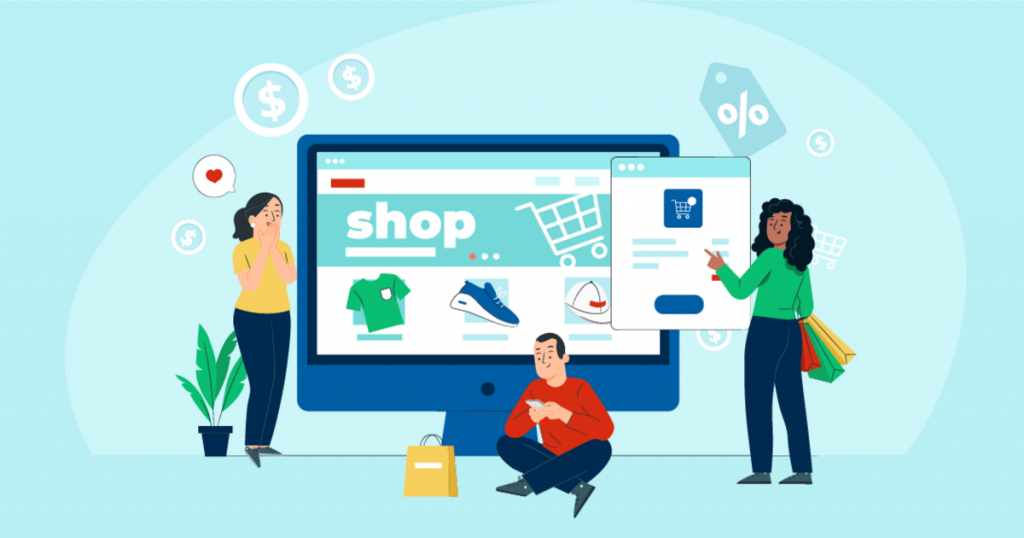Within the current technology boom, there has been an explosion in the appearance of E-commerce. The climate created by the pandemic has forced many companies into adopting e-commerce websites. However, even before the start of 2020, there had been a gradual shift away from traditional stores.
E-commerce 2022
To maintain relevance, companies would have had to make the switch sooner or later. Accompanying this transition from physical to digital, this new landscape reshapes the way in which consumers shop and interact with stores. As more stores begin to digitize and shift to better suit e-commerce shopping trends, what does that mean for the future of shopping and traditional stores?

Disappearing Retail Stores
During times of financial strain, it is common for businesses to close down. Store owners are able to reduce their losses by temporarily closing. However, some of these closings went from temporary to permanent. Since the last recession, physical stores have gradually faded into a thing of the past.
In 2019, the United States saw approximately 9,300 store closings. Last year in France nearly 2000 stores closed–and this is only from the actions of ten brands. We see businesses from across all industries opening fewer in-person stores in favor of using online platforms. Some brands are even opting to be exclusively online without physical stores.
Why Are We Moving to Online?
As an increasing number of companies and brands choose to connect with their shoppers online, we see it becoming less viable to operate brick and mortar stores. This is the inevitable progression of the marketplace. Stores of all sizes are affected. Even large, name-brand stores have been forced into shutting down some of their locations. Just last year in 2020, six department stores filed for bankruptcy.
Benefits of E-commerce
An online-only shopping experience reduces the overhead expenses a company may have to deal with. For instance, it can be more cost-effective to maintain a website rather than paying a monthly lease. More than the cost-effectiveness of an e-commerce website, it allows for stores to be more easily accessible for a wider audience.
From a customer’s perspective, online shopping is fun, quick, and easy. The days of navigating crowded parking lots and waiting in long lines are a thing of the past. E-commerce websites have made it possible to purchase groceries, clothing, tickets, and even cars over the internet. As if the convenience of not having to leave home to shop wasn’t enough, it is easier than ever to find a store’s return and exchange policy.
E-commerce Websites Design
User Interface
When building an e-commerce website, the layout that customers will interact with is the user interface. A user’s experience will be influenced by the interface. If you were to look at any of your favorite websites, you will notice that they have a few things in common.
- Consistent page design: Does each page have the same format? Meaning that the menu and navigation area should be in the same spot across all pages. If there are any animations on the site are the same ones used or is each animation different from the last? More than that, websites across the internet have a similar layout. Following this layout makes it quicker and easier for visitors to figure out how to interact with your page.
- Easy navigation: Is it easy for a visitor to find the different pages on your website? Can they easily switch between the pages? Another important consideration is whether or not links will open new tabs.
- Appealing color scheme: An appealing color scheme will elevate the overall look of a site. Certain colors are associated with certain industries and traits, so picking the right colors can quickly communicate the type of business you are in and the values that you possess.
To create a layout that provides the best experience for all visitors, a developer must think about user accessibility. User accessibility is designing while also being considerate of people with varying ability levels. For instance, you may want to choose color schemes that look appealing and distinguishable for people with variations of color blindness.
User Experience
E-commerce websites have been so successful because customers have been provided with an experience that rivals shopping in person. This shopping experience is largely influenced by a user’s experience with the website. Offering a simple, logical, and enjoyable shopping experience is easier than you might think as long as you keep a few things in mind. When thinking about user experience, a few things to consider include how and why a user might interact with a site along with its responsiveness.
Suggesting similar products is another way in which you can improve a user’s e-commerce website experience. You can help your clients find something even better for them. By providing recommendations, you also make it much easier to navigate your site.
Yet another option is to dedicate space for product and service reviews. When online shopping, many people often will use customer reviews to help them decide whether it is worth spending money on a product. When you can’t physically examine a product before buying it, then there is nothing better than using personal experiences and social proof to turn visitors into clients.
High-resolution images and product descriptions are as important as reviews when crafting a great experience. Customers don’t have the opportunity to see products in person before they are delivered, so it is important to have images that show their true quality. Showing your products well should be a top priority for any e-commerce platform.
E-commerce Website Tools
Every e-commerce store has to implement some sort of security and payment methods. Having a reliable and secure connection reassures your clients that it’s safe to purchase from your store and gives them options. One of the most popular platforms that online stores may use is Shopify.
Shopify is a platform that integrates different aspects of an online store into one easy-to-find place. So rather than managing marketing with one provider, payments with another, and shipping with a different one, Shopify merges it all.
If you were only looking for a provider to make secure transactions, PayPal is another amazing option. PayPal has also been highlighted as being great for young businesses. With PayPal, you can accept payments made with credit cards, debit cards, PayPal, Venmo, and PayPal Credit.
Running a business and website takes a lot of work. Remembering to include a few key components into your models can help to ease some of the stress. If you are currently searching for ways to improve your e-commerce site, check out our article about e-commerce partners.






